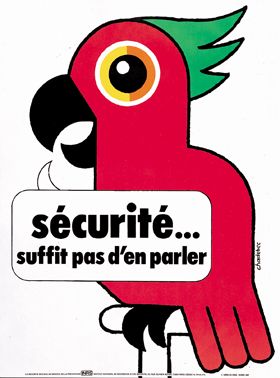INRS Posters
Picturing Safety
The aim of INRS, when it was founded, was to disseminate a spirit of occupational safety culture and to change behaviours. Since 1947, the Institute has thus produced over 900 creations of various formats. Over the years, the information has become more technical, underpinned by studies and research conducted internally, but posters still remain a preferred communications medium.

For many years now, INRS safety posters have been one of the ways of passing on risk prevention messages to workers, and, as a result, posters form an important media through which INRS has become known. Naturally, other media also serve to raise awareness and to inform companies and their employees: films, magazines, leaflets and technical works, etc., but posters immediately reach the people faced with occupational risks. The purpose of the posters is to disseminate awareness-raising messages to those who are in contact with the hazard or danger so as to prevent occupational accidents.
Risk prevention messages through the ages
Looking back over the poster output from the start, various characteristics appear.
Firstly the content and the tone of the messages have changed. In the post-war years, guilt-inducing messages were still used, and emphasis was put on the employees’ responsibility and liability to themselves, to their colleagues, and even to their families whose subsistence depended on them. The picture that was drawn was intentionally realistic, and the accident was shown.

A more overall approach to safety was used, encouraging viewers to think, and abstraction both in the message and in the drawing grew over the years. The risk to be avoided was indicated in preference to the accident having occurred. The poster artist trusted the onlooker to wonder about and to decide on the behaviour to adopt or to change, as applicable.
At the end of the nineteen sixties, society as a whole had moved on, and to achieve the desired effectiveness for the communications, posters appealed to the entire spectrum of psychological motivations, from humour to fear, with great care always being taken to make them aesthetic. The persons for whom the poster was intended was respected, and the poster appealed to their sensitivity and their intelligence of the situations, rather than seeking to make them feel guilty. They became an active partner in their own safety and in the safety of others, instead of an operator who would be punished for not complying with instructions.

The subjects addressed have changed at the same pace as the working world. New risks have emerged, and the prevalence of various hazards has changed. Other risks such as risks related to asbestos, and to hazardous chemicals have come to the fore. Today, risks related to physical activity (carrying loads, handling goods, and performing repetitive movements that can cause musculoskeletal disorders, for example), and psychosocial risks (stress, burnout, etc.) are now topical subjects for poster creation. Other risks are appearing with information and communications technology, and with forms of remote working, etc., that have the feature of being less "visible", and are doubtless more difficult for posters to address.
Over 200 posters and stickers are today still proposed to companies by INRS. The posters exist in a variety of formats. Printed in several tens of thousands of copies, and re-printed many times, these productions are intended to be posted out in the companies: on the walls of workshops, next to machinery, or in all of the places frequented by employees.
